Assignment 2: Ethics for Managers - IKEA Corporate Governance Analysis
VerifiedAdded on 2020/02/18
|17
|4675
|107
Report
AI Summary
This report provides a comprehensive analysis of IKEA's corporate governance and ethical practices, examining various ethical issues the company has faced, such as employee spying, product quality concerns, and labor practices. It delves into IKEA's vision, mission, core values, and the IWAY code of conduct, illustrating how these elements shape the company's ethical behavior. The report applies Carroll's Four-Part Model of Corporate Social Responsibility to assess IKEA's performance across economic, legal, ethical, and philanthropic dimensions. Furthermore, it identifies and analyzes IKEA's key stakeholders based on the attributes of power, legitimacy, and urgency. The study concludes with recommendations for enhancing IKEA's ethical conduct and addresses areas where the company can improve its practices, offering a detailed assessment of IKEA's ethical standing and areas for future development.

Paraphrase This Document
Need a fresh take? Get an instant paraphrase of this document with our AI Paraphraser
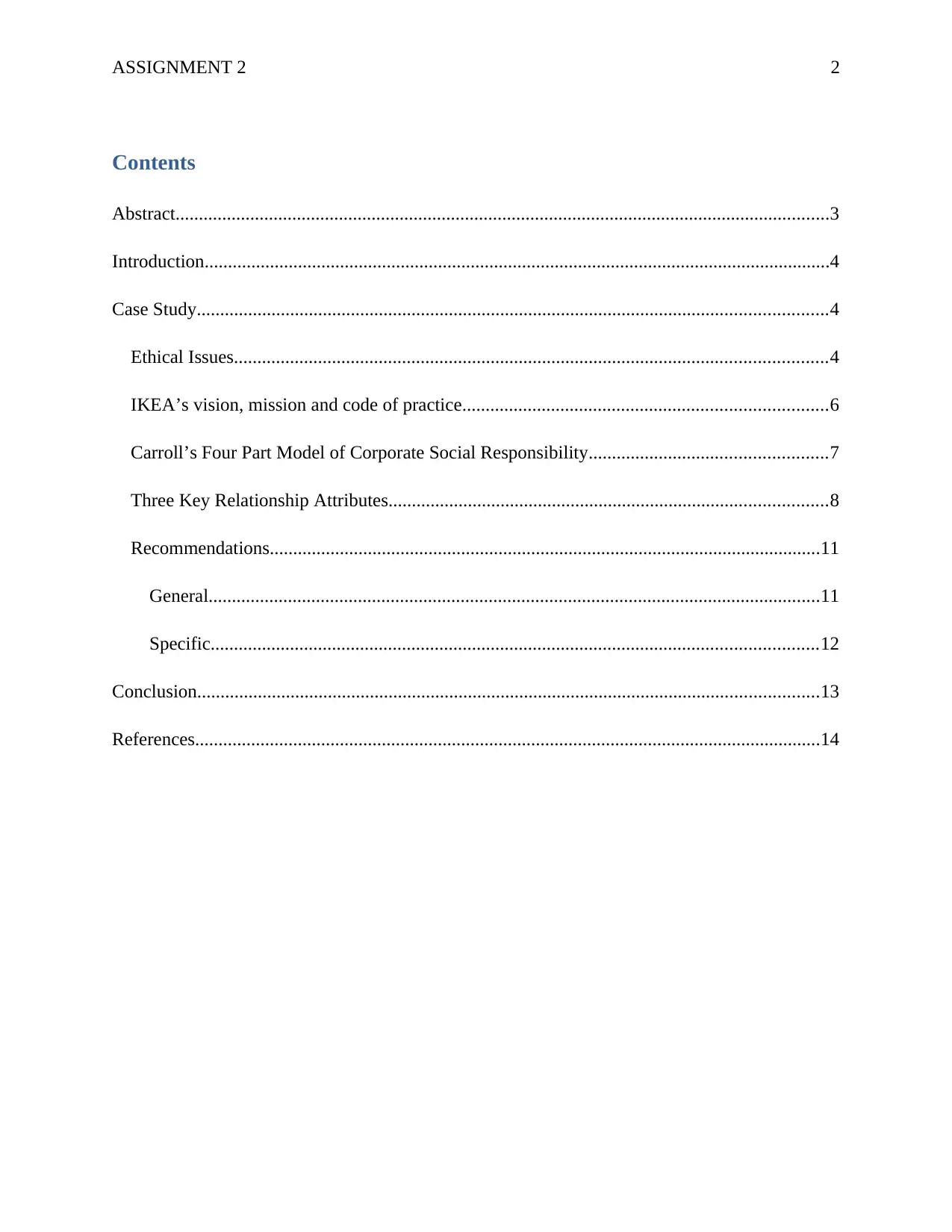
ASSIGNMENT 2 2
Contents
Abstract............................................................................................................................................3
Introduction......................................................................................................................................4
Case Study.......................................................................................................................................4
Ethical Issues...............................................................................................................................4
IKEA’s vision, mission and code of practice..............................................................................6
Carroll’s Four Part Model of Corporate Social Responsibility...................................................7
Three Key Relationship Attributes..............................................................................................8
Recommendations......................................................................................................................11
General...................................................................................................................................11
Specific..................................................................................................................................12
Conclusion.....................................................................................................................................13
References......................................................................................................................................14
Contents
Abstract............................................................................................................................................3
Introduction......................................................................................................................................4
Case Study.......................................................................................................................................4
Ethical Issues...............................................................................................................................4
IKEA’s vision, mission and code of practice..............................................................................6
Carroll’s Four Part Model of Corporate Social Responsibility...................................................7
Three Key Relationship Attributes..............................................................................................8
Recommendations......................................................................................................................11
General...................................................................................................................................11
Specific..................................................................................................................................12
Conclusion.....................................................................................................................................13
References......................................................................................................................................14
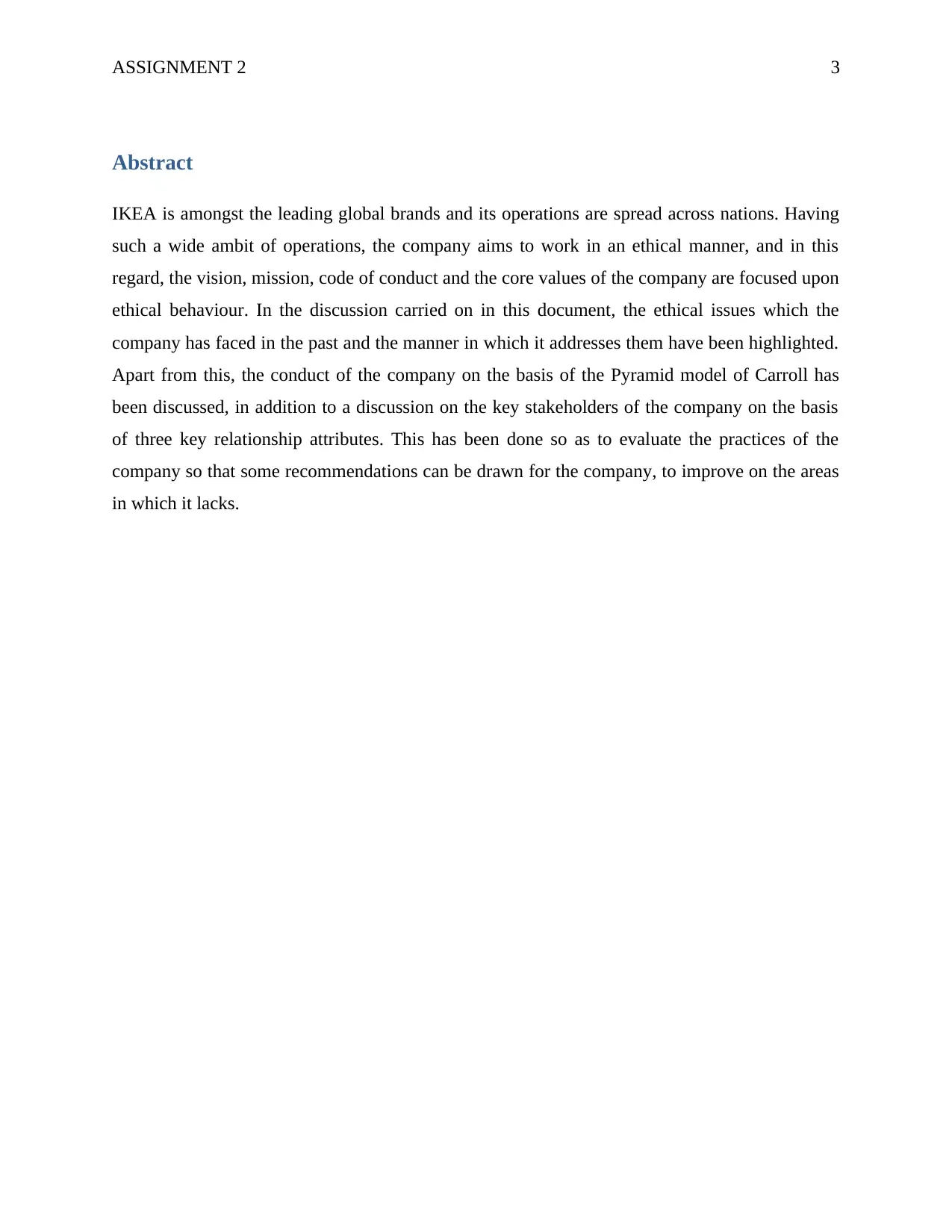
ASSIGNMENT 2 3
Abstract
IKEA is amongst the leading global brands and its operations are spread across nations. Having
such a wide ambit of operations, the company aims to work in an ethical manner, and in this
regard, the vision, mission, code of conduct and the core values of the company are focused upon
ethical behaviour. In the discussion carried on in this document, the ethical issues which the
company has faced in the past and the manner in which it addresses them have been highlighted.
Apart from this, the conduct of the company on the basis of the Pyramid model of Carroll has
been discussed, in addition to a discussion on the key stakeholders of the company on the basis
of three key relationship attributes. This has been done so as to evaluate the practices of the
company so that some recommendations can be drawn for the company, to improve on the areas
in which it lacks.
Abstract
IKEA is amongst the leading global brands and its operations are spread across nations. Having
such a wide ambit of operations, the company aims to work in an ethical manner, and in this
regard, the vision, mission, code of conduct and the core values of the company are focused upon
ethical behaviour. In the discussion carried on in this document, the ethical issues which the
company has faced in the past and the manner in which it addresses them have been highlighted.
Apart from this, the conduct of the company on the basis of the Pyramid model of Carroll has
been discussed, in addition to a discussion on the key stakeholders of the company on the basis
of three key relationship attributes. This has been done so as to evaluate the practices of the
company so that some recommendations can be drawn for the company, to improve on the areas
in which it lacks.
⊘ This is a preview!⊘
Do you want full access?
Subscribe today to unlock all pages.

Trusted by 1+ million students worldwide
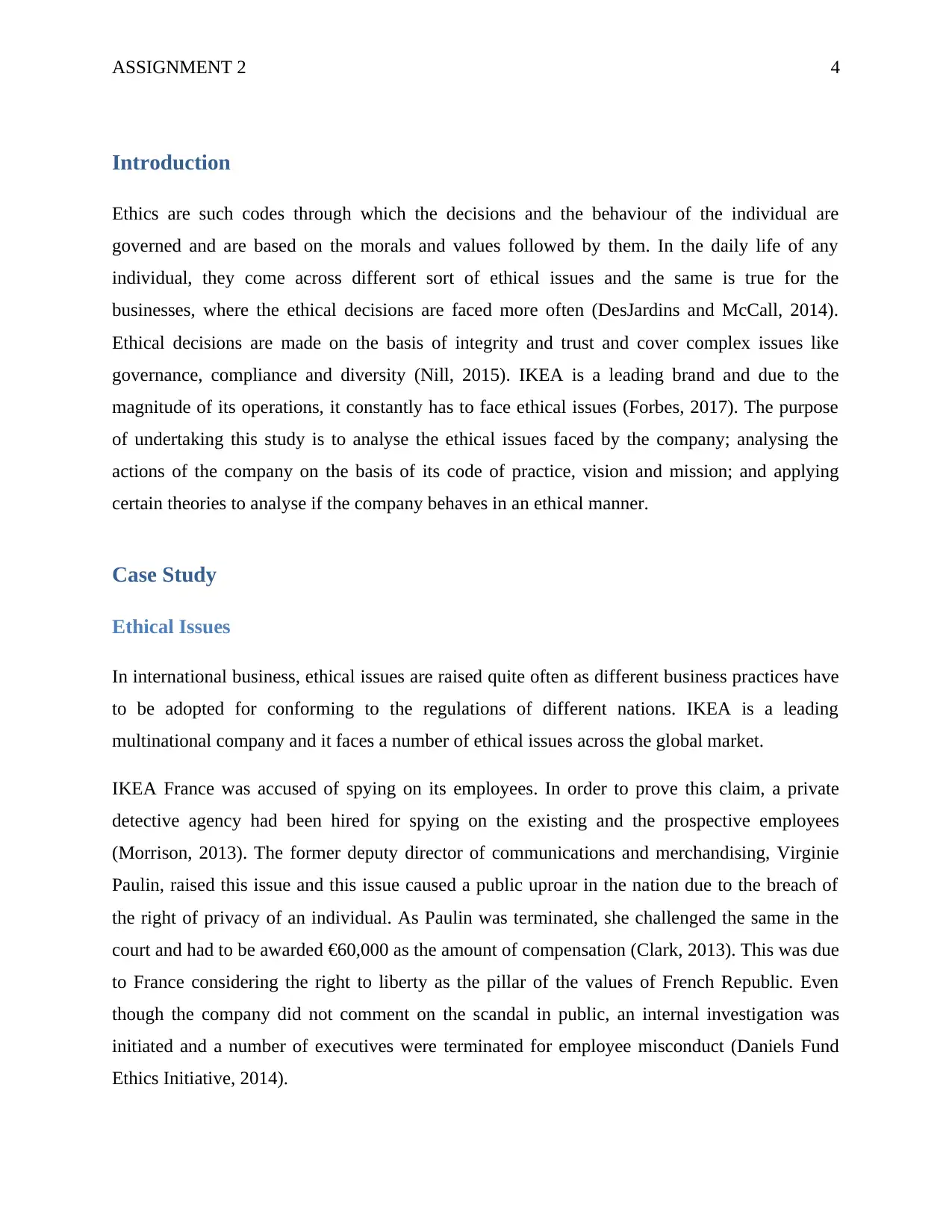
ASSIGNMENT 2 4
Introduction
Ethics are such codes through which the decisions and the behaviour of the individual are
governed and are based on the morals and values followed by them. In the daily life of any
individual, they come across different sort of ethical issues and the same is true for the
businesses, where the ethical decisions are faced more often (DesJardins and McCall, 2014).
Ethical decisions are made on the basis of integrity and trust and cover complex issues like
governance, compliance and diversity (Nill, 2015). IKEA is a leading brand and due to the
magnitude of its operations, it constantly has to face ethical issues (Forbes, 2017). The purpose
of undertaking this study is to analyse the ethical issues faced by the company; analysing the
actions of the company on the basis of its code of practice, vision and mission; and applying
certain theories to analyse if the company behaves in an ethical manner.
Case Study
Ethical Issues
In international business, ethical issues are raised quite often as different business practices have
to be adopted for conforming to the regulations of different nations. IKEA is a leading
multinational company and it faces a number of ethical issues across the global market.
IKEA France was accused of spying on its employees. In order to prove this claim, a private
detective agency had been hired for spying on the existing and the prospective employees
(Morrison, 2013). The former deputy director of communications and merchandising, Virginie
Paulin, raised this issue and this issue caused a public uproar in the nation due to the breach of
the right of privacy of an individual. As Paulin was terminated, she challenged the same in the
court and had to be awarded €60,000 as the amount of compensation (Clark, 2013). This was due
to France considering the right to liberty as the pillar of the values of French Republic. Even
though the company did not comment on the scandal in public, an internal investigation was
initiated and a number of executives were terminated for employee misconduct (Daniels Fund
Ethics Initiative, 2014).
Introduction
Ethics are such codes through which the decisions and the behaviour of the individual are
governed and are based on the morals and values followed by them. In the daily life of any
individual, they come across different sort of ethical issues and the same is true for the
businesses, where the ethical decisions are faced more often (DesJardins and McCall, 2014).
Ethical decisions are made on the basis of integrity and trust and cover complex issues like
governance, compliance and diversity (Nill, 2015). IKEA is a leading brand and due to the
magnitude of its operations, it constantly has to face ethical issues (Forbes, 2017). The purpose
of undertaking this study is to analyse the ethical issues faced by the company; analysing the
actions of the company on the basis of its code of practice, vision and mission; and applying
certain theories to analyse if the company behaves in an ethical manner.
Case Study
Ethical Issues
In international business, ethical issues are raised quite often as different business practices have
to be adopted for conforming to the regulations of different nations. IKEA is a leading
multinational company and it faces a number of ethical issues across the global market.
IKEA France was accused of spying on its employees. In order to prove this claim, a private
detective agency had been hired for spying on the existing and the prospective employees
(Morrison, 2013). The former deputy director of communications and merchandising, Virginie
Paulin, raised this issue and this issue caused a public uproar in the nation due to the breach of
the right of privacy of an individual. As Paulin was terminated, she challenged the same in the
court and had to be awarded €60,000 as the amount of compensation (Clark, 2013). This was due
to France considering the right to liberty as the pillar of the values of French Republic. Even
though the company did not comment on the scandal in public, an internal investigation was
initiated and a number of executives were terminated for employee misconduct (Daniels Fund
Ethics Initiative, 2014).
Paraphrase This Document
Need a fresh take? Get an instant paraphrase of this document with our AI Paraphraser
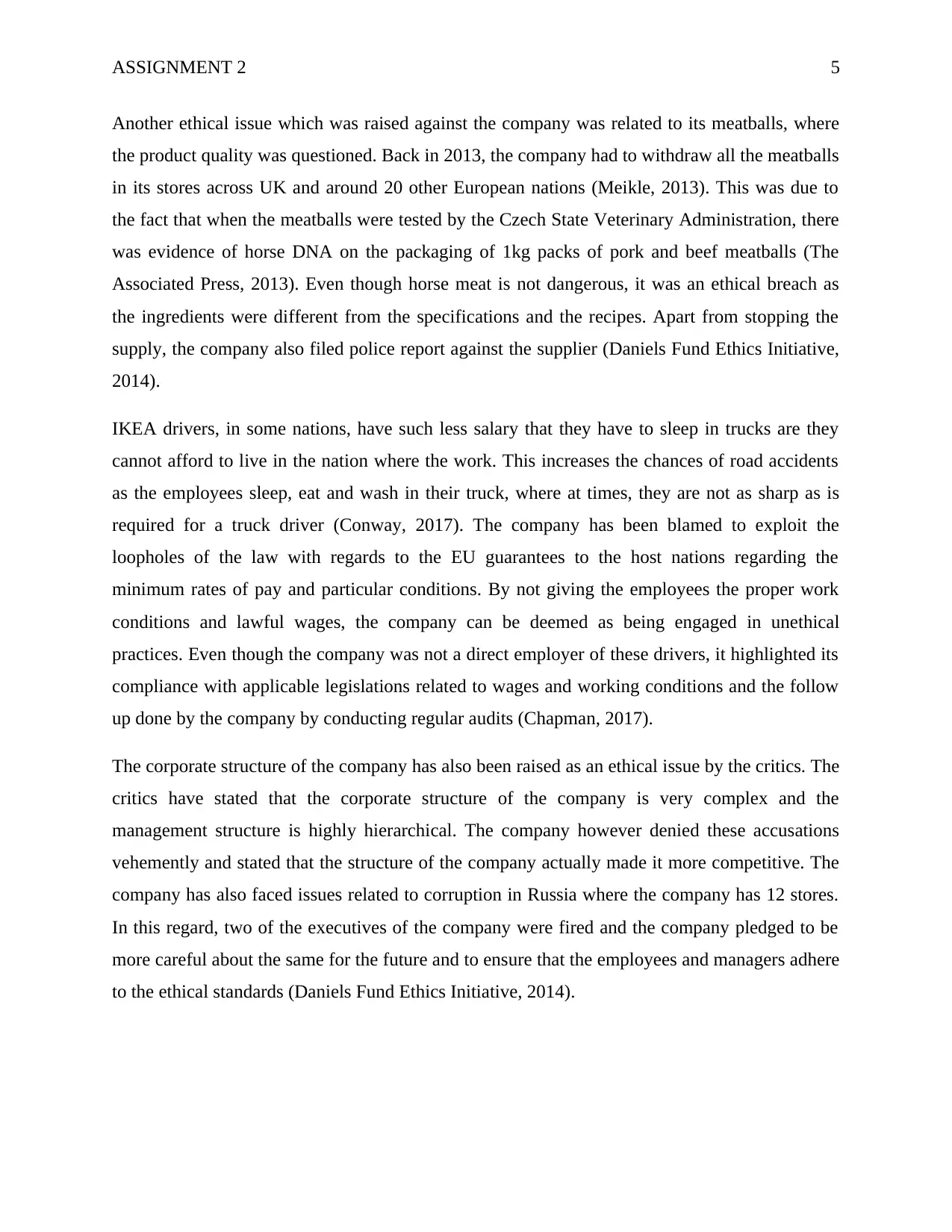
ASSIGNMENT 2 5
Another ethical issue which was raised against the company was related to its meatballs, where
the product quality was questioned. Back in 2013, the company had to withdraw all the meatballs
in its stores across UK and around 20 other European nations (Meikle, 2013). This was due to
the fact that when the meatballs were tested by the Czech State Veterinary Administration, there
was evidence of horse DNA on the packaging of 1kg packs of pork and beef meatballs (The
Associated Press, 2013). Even though horse meat is not dangerous, it was an ethical breach as
the ingredients were different from the specifications and the recipes. Apart from stopping the
supply, the company also filed police report against the supplier (Daniels Fund Ethics Initiative,
2014).
IKEA drivers, in some nations, have such less salary that they have to sleep in trucks are they
cannot afford to live in the nation where the work. This increases the chances of road accidents
as the employees sleep, eat and wash in their truck, where at times, they are not as sharp as is
required for a truck driver (Conway, 2017). The company has been blamed to exploit the
loopholes of the law with regards to the EU guarantees to the host nations regarding the
minimum rates of pay and particular conditions. By not giving the employees the proper work
conditions and lawful wages, the company can be deemed as being engaged in unethical
practices. Even though the company was not a direct employer of these drivers, it highlighted its
compliance with applicable legislations related to wages and working conditions and the follow
up done by the company by conducting regular audits (Chapman, 2017).
The corporate structure of the company has also been raised as an ethical issue by the critics. The
critics have stated that the corporate structure of the company is very complex and the
management structure is highly hierarchical. The company however denied these accusations
vehemently and stated that the structure of the company actually made it more competitive. The
company has also faced issues related to corruption in Russia where the company has 12 stores.
In this regard, two of the executives of the company were fired and the company pledged to be
more careful about the same for the future and to ensure that the employees and managers adhere
to the ethical standards (Daniels Fund Ethics Initiative, 2014).
Another ethical issue which was raised against the company was related to its meatballs, where
the product quality was questioned. Back in 2013, the company had to withdraw all the meatballs
in its stores across UK and around 20 other European nations (Meikle, 2013). This was due to
the fact that when the meatballs were tested by the Czech State Veterinary Administration, there
was evidence of horse DNA on the packaging of 1kg packs of pork and beef meatballs (The
Associated Press, 2013). Even though horse meat is not dangerous, it was an ethical breach as
the ingredients were different from the specifications and the recipes. Apart from stopping the
supply, the company also filed police report against the supplier (Daniels Fund Ethics Initiative,
2014).
IKEA drivers, in some nations, have such less salary that they have to sleep in trucks are they
cannot afford to live in the nation where the work. This increases the chances of road accidents
as the employees sleep, eat and wash in their truck, where at times, they are not as sharp as is
required for a truck driver (Conway, 2017). The company has been blamed to exploit the
loopholes of the law with regards to the EU guarantees to the host nations regarding the
minimum rates of pay and particular conditions. By not giving the employees the proper work
conditions and lawful wages, the company can be deemed as being engaged in unethical
practices. Even though the company was not a direct employer of these drivers, it highlighted its
compliance with applicable legislations related to wages and working conditions and the follow
up done by the company by conducting regular audits (Chapman, 2017).
The corporate structure of the company has also been raised as an ethical issue by the critics. The
critics have stated that the corporate structure of the company is very complex and the
management structure is highly hierarchical. The company however denied these accusations
vehemently and stated that the structure of the company actually made it more competitive. The
company has also faced issues related to corruption in Russia where the company has 12 stores.
In this regard, two of the executives of the company were fired and the company pledged to be
more careful about the same for the future and to ensure that the employees and managers adhere
to the ethical standards (Daniels Fund Ethics Initiative, 2014).
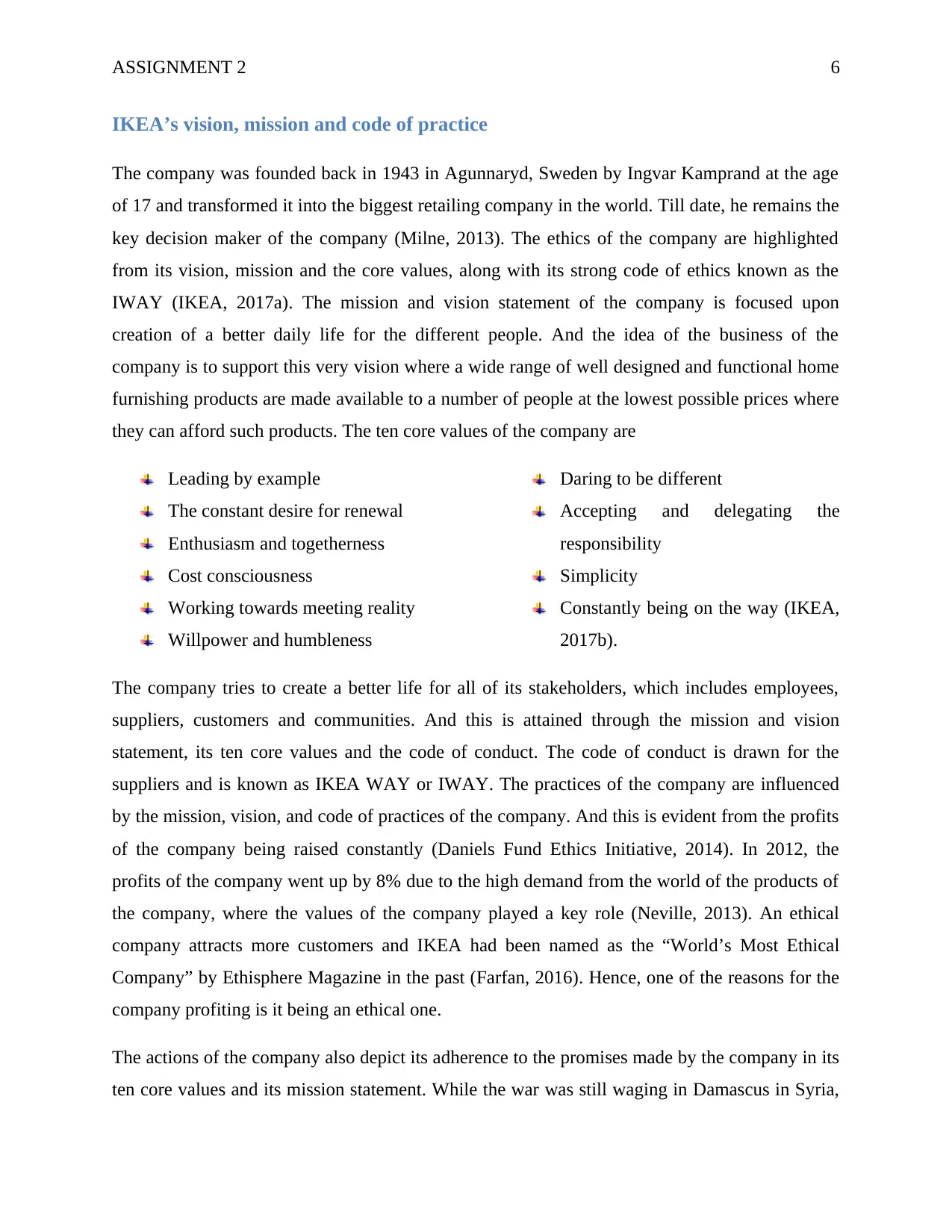
ASSIGNMENT 2 6
IKEA’s vision, mission and code of practice
The company was founded back in 1943 in Agunnaryd, Sweden by Ingvar Kamprand at the age
of 17 and transformed it into the biggest retailing company in the world. Till date, he remains the
key decision maker of the company (Milne, 2013). The ethics of the company are highlighted
from its vision, mission and the core values, along with its strong code of ethics known as the
IWAY (IKEA, 2017a). The mission and vision statement of the company is focused upon
creation of a better daily life for the different people. And the idea of the business of the
company is to support this very vision where a wide range of well designed and functional home
furnishing products are made available to a number of people at the lowest possible prices where
they can afford such products. The ten core values of the company are
Leading by example
The constant desire for renewal
Enthusiasm and togetherness
Cost consciousness
Working towards meeting reality
Willpower and humbleness
Daring to be different
Accepting and delegating the
responsibility
Simplicity
Constantly being on the way (IKEA,
2017b).
The company tries to create a better life for all of its stakeholders, which includes employees,
suppliers, customers and communities. And this is attained through the mission and vision
statement, its ten core values and the code of conduct. The code of conduct is drawn for the
suppliers and is known as IKEA WAY or IWAY. The practices of the company are influenced
by the mission, vision, and code of practices of the company. And this is evident from the profits
of the company being raised constantly (Daniels Fund Ethics Initiative, 2014). In 2012, the
profits of the company went up by 8% due to the high demand from the world of the products of
the company, where the values of the company played a key role (Neville, 2013). An ethical
company attracts more customers and IKEA had been named as the “World’s Most Ethical
Company” by Ethisphere Magazine in the past (Farfan, 2016). Hence, one of the reasons for the
company profiting is it being an ethical one.
The actions of the company also depict its adherence to the promises made by the company in its
ten core values and its mission statement. While the war was still waging in Damascus in Syria,
IKEA’s vision, mission and code of practice
The company was founded back in 1943 in Agunnaryd, Sweden by Ingvar Kamprand at the age
of 17 and transformed it into the biggest retailing company in the world. Till date, he remains the
key decision maker of the company (Milne, 2013). The ethics of the company are highlighted
from its vision, mission and the core values, along with its strong code of ethics known as the
IWAY (IKEA, 2017a). The mission and vision statement of the company is focused upon
creation of a better daily life for the different people. And the idea of the business of the
company is to support this very vision where a wide range of well designed and functional home
furnishing products are made available to a number of people at the lowest possible prices where
they can afford such products. The ten core values of the company are
Leading by example
The constant desire for renewal
Enthusiasm and togetherness
Cost consciousness
Working towards meeting reality
Willpower and humbleness
Daring to be different
Accepting and delegating the
responsibility
Simplicity
Constantly being on the way (IKEA,
2017b).
The company tries to create a better life for all of its stakeholders, which includes employees,
suppliers, customers and communities. And this is attained through the mission and vision
statement, its ten core values and the code of conduct. The code of conduct is drawn for the
suppliers and is known as IKEA WAY or IWAY. The practices of the company are influenced
by the mission, vision, and code of practices of the company. And this is evident from the profits
of the company being raised constantly (Daniels Fund Ethics Initiative, 2014). In 2012, the
profits of the company went up by 8% due to the high demand from the world of the products of
the company, where the values of the company played a key role (Neville, 2013). An ethical
company attracts more customers and IKEA had been named as the “World’s Most Ethical
Company” by Ethisphere Magazine in the past (Farfan, 2016). Hence, one of the reasons for the
company profiting is it being an ethical one.
The actions of the company also depict its adherence to the promises made by the company in its
ten core values and its mission statement. While the war was still waging in Damascus in Syria,
⊘ This is a preview!⊘
Do you want full access?
Subscribe today to unlock all pages.

Trusted by 1+ million students worldwide
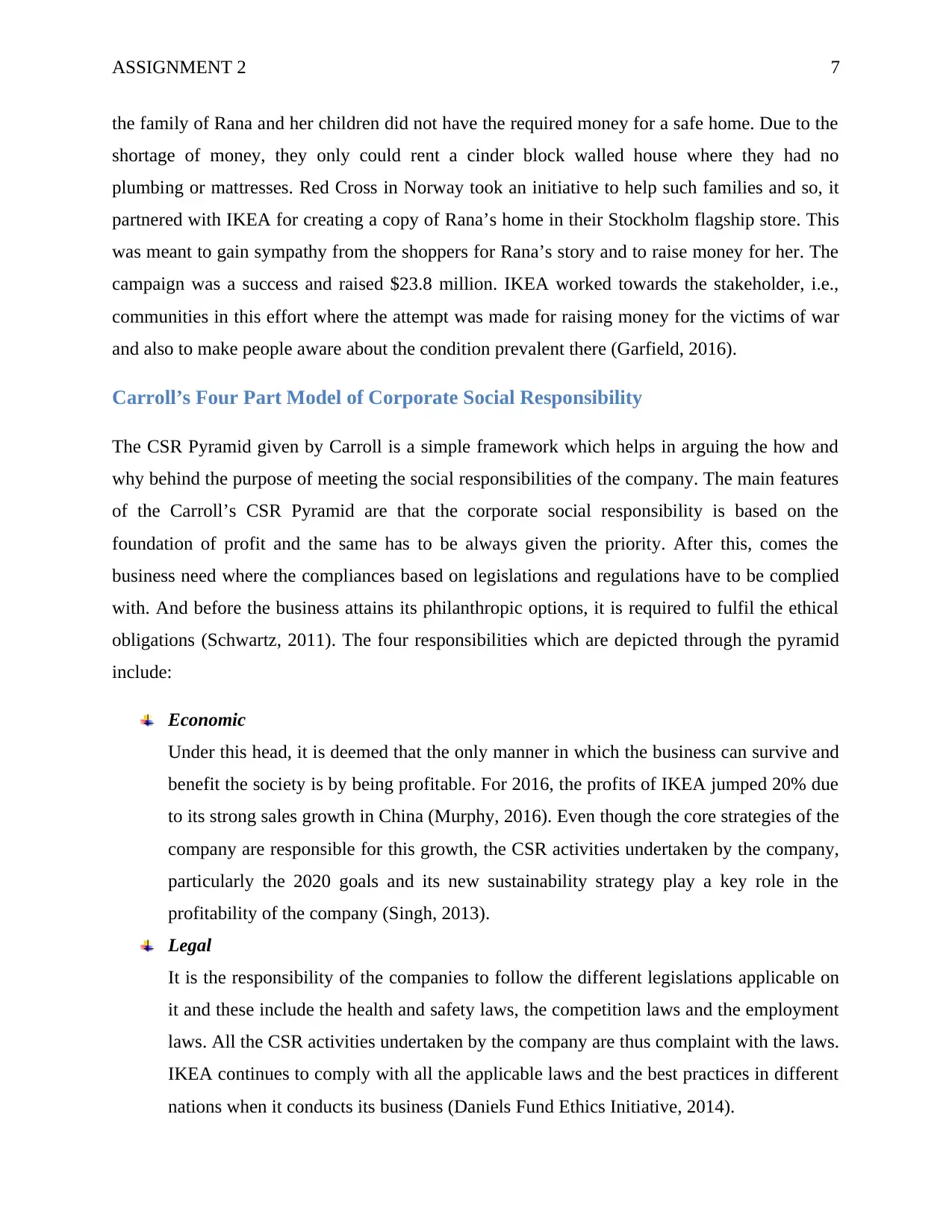
ASSIGNMENT 2 7
the family of Rana and her children did not have the required money for a safe home. Due to the
shortage of money, they only could rent a cinder block walled house where they had no
plumbing or mattresses. Red Cross in Norway took an initiative to help such families and so, it
partnered with IKEA for creating a copy of Rana’s home in their Stockholm flagship store. This
was meant to gain sympathy from the shoppers for Rana’s story and to raise money for her. The
campaign was a success and raised $23.8 million. IKEA worked towards the stakeholder, i.e.,
communities in this effort where the attempt was made for raising money for the victims of war
and also to make people aware about the condition prevalent there (Garfield, 2016).
Carroll’s Four Part Model of Corporate Social Responsibility
The CSR Pyramid given by Carroll is a simple framework which helps in arguing the how and
why behind the purpose of meeting the social responsibilities of the company. The main features
of the Carroll’s CSR Pyramid are that the corporate social responsibility is based on the
foundation of profit and the same has to be always given the priority. After this, comes the
business need where the compliances based on legislations and regulations have to be complied
with. And before the business attains its philanthropic options, it is required to fulfil the ethical
obligations (Schwartz, 2011). The four responsibilities which are depicted through the pyramid
include:
Economic
Under this head, it is deemed that the only manner in which the business can survive and
benefit the society is by being profitable. For 2016, the profits of IKEA jumped 20% due
to its strong sales growth in China (Murphy, 2016). Even though the core strategies of the
company are responsible for this growth, the CSR activities undertaken by the company,
particularly the 2020 goals and its new sustainability strategy play a key role in the
profitability of the company (Singh, 2013).
Legal
It is the responsibility of the companies to follow the different legislations applicable on
it and these include the health and safety laws, the competition laws and the employment
laws. All the CSR activities undertaken by the company are thus complaint with the laws.
IKEA continues to comply with all the applicable laws and the best practices in different
nations when it conducts its business (Daniels Fund Ethics Initiative, 2014).
the family of Rana and her children did not have the required money for a safe home. Due to the
shortage of money, they only could rent a cinder block walled house where they had no
plumbing or mattresses. Red Cross in Norway took an initiative to help such families and so, it
partnered with IKEA for creating a copy of Rana’s home in their Stockholm flagship store. This
was meant to gain sympathy from the shoppers for Rana’s story and to raise money for her. The
campaign was a success and raised $23.8 million. IKEA worked towards the stakeholder, i.e.,
communities in this effort where the attempt was made for raising money for the victims of war
and also to make people aware about the condition prevalent there (Garfield, 2016).
Carroll’s Four Part Model of Corporate Social Responsibility
The CSR Pyramid given by Carroll is a simple framework which helps in arguing the how and
why behind the purpose of meeting the social responsibilities of the company. The main features
of the Carroll’s CSR Pyramid are that the corporate social responsibility is based on the
foundation of profit and the same has to be always given the priority. After this, comes the
business need where the compliances based on legislations and regulations have to be complied
with. And before the business attains its philanthropic options, it is required to fulfil the ethical
obligations (Schwartz, 2011). The four responsibilities which are depicted through the pyramid
include:
Economic
Under this head, it is deemed that the only manner in which the business can survive and
benefit the society is by being profitable. For 2016, the profits of IKEA jumped 20% due
to its strong sales growth in China (Murphy, 2016). Even though the core strategies of the
company are responsible for this growth, the CSR activities undertaken by the company,
particularly the 2020 goals and its new sustainability strategy play a key role in the
profitability of the company (Singh, 2013).
Legal
It is the responsibility of the companies to follow the different legislations applicable on
it and these include the health and safety laws, the competition laws and the employment
laws. All the CSR activities undertaken by the company are thus complaint with the laws.
IKEA continues to comply with all the applicable laws and the best practices in different
nations when it conducts its business (Daniels Fund Ethics Initiative, 2014).
Paraphrase This Document
Need a fresh take? Get an instant paraphrase of this document with our AI Paraphraser
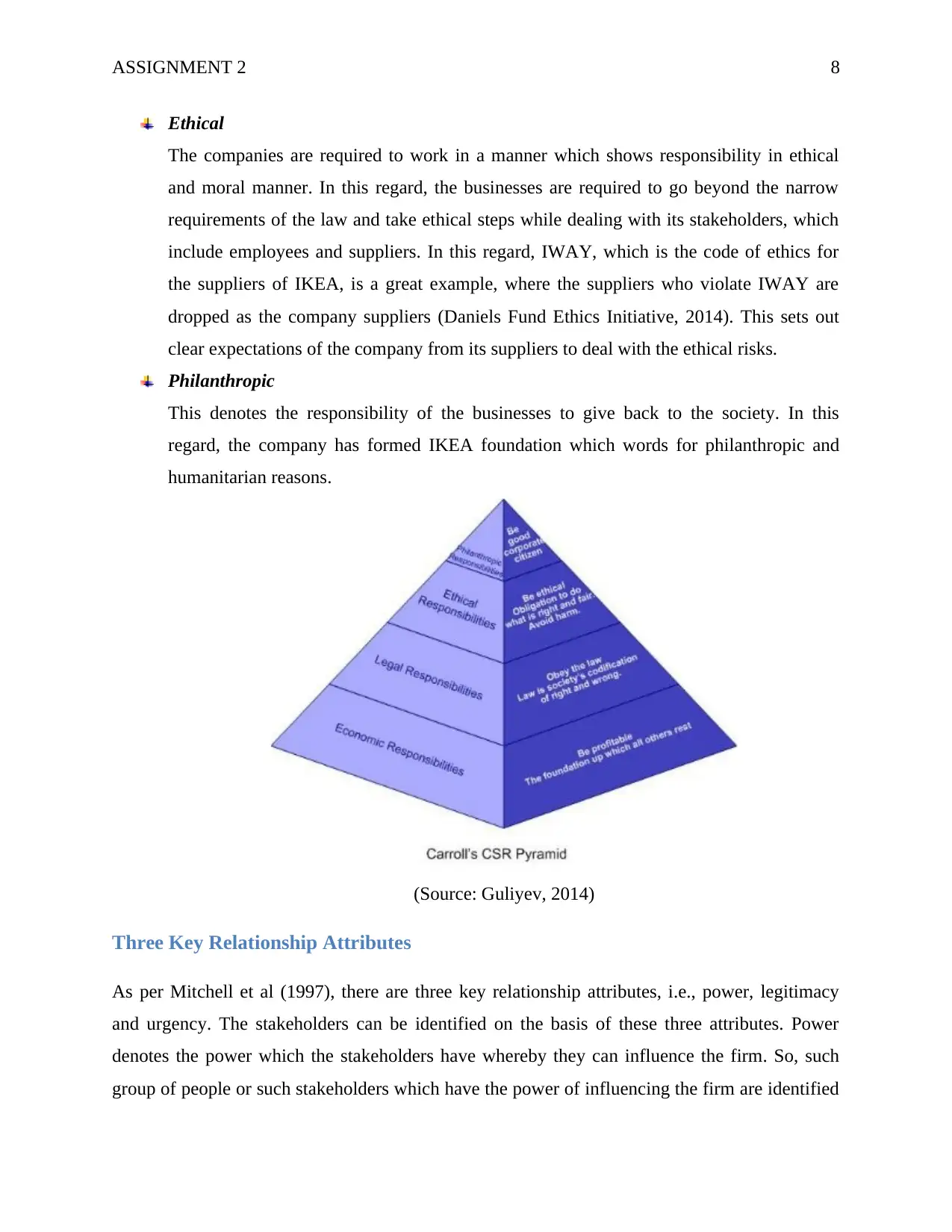
ASSIGNMENT 2 8
Ethical
The companies are required to work in a manner which shows responsibility in ethical
and moral manner. In this regard, the businesses are required to go beyond the narrow
requirements of the law and take ethical steps while dealing with its stakeholders, which
include employees and suppliers. In this regard, IWAY, which is the code of ethics for
the suppliers of IKEA, is a great example, where the suppliers who violate IWAY are
dropped as the company suppliers (Daniels Fund Ethics Initiative, 2014). This sets out
clear expectations of the company from its suppliers to deal with the ethical risks.
Philanthropic
This denotes the responsibility of the businesses to give back to the society. In this
regard, the company has formed IKEA foundation which words for philanthropic and
humanitarian reasons.
(Source: Guliyev, 2014)
Three Key Relationship Attributes
As per Mitchell et al (1997), there are three key relationship attributes, i.e., power, legitimacy
and urgency. The stakeholders can be identified on the basis of these three attributes. Power
denotes the power which the stakeholders have whereby they can influence the firm. So, such
group of people or such stakeholders which have the power of influencing the firm are identified
Ethical
The companies are required to work in a manner which shows responsibility in ethical
and moral manner. In this regard, the businesses are required to go beyond the narrow
requirements of the law and take ethical steps while dealing with its stakeholders, which
include employees and suppliers. In this regard, IWAY, which is the code of ethics for
the suppliers of IKEA, is a great example, where the suppliers who violate IWAY are
dropped as the company suppliers (Daniels Fund Ethics Initiative, 2014). This sets out
clear expectations of the company from its suppliers to deal with the ethical risks.
Philanthropic
This denotes the responsibility of the businesses to give back to the society. In this
regard, the company has formed IKEA foundation which words for philanthropic and
humanitarian reasons.
(Source: Guliyev, 2014)
Three Key Relationship Attributes
As per Mitchell et al (1997), there are three key relationship attributes, i.e., power, legitimacy
and urgency. The stakeholders can be identified on the basis of these three attributes. Power
denotes the power which the stakeholders have whereby they can influence the firm. So, such
group of people or such stakeholders which have the power of influencing the firm are identified
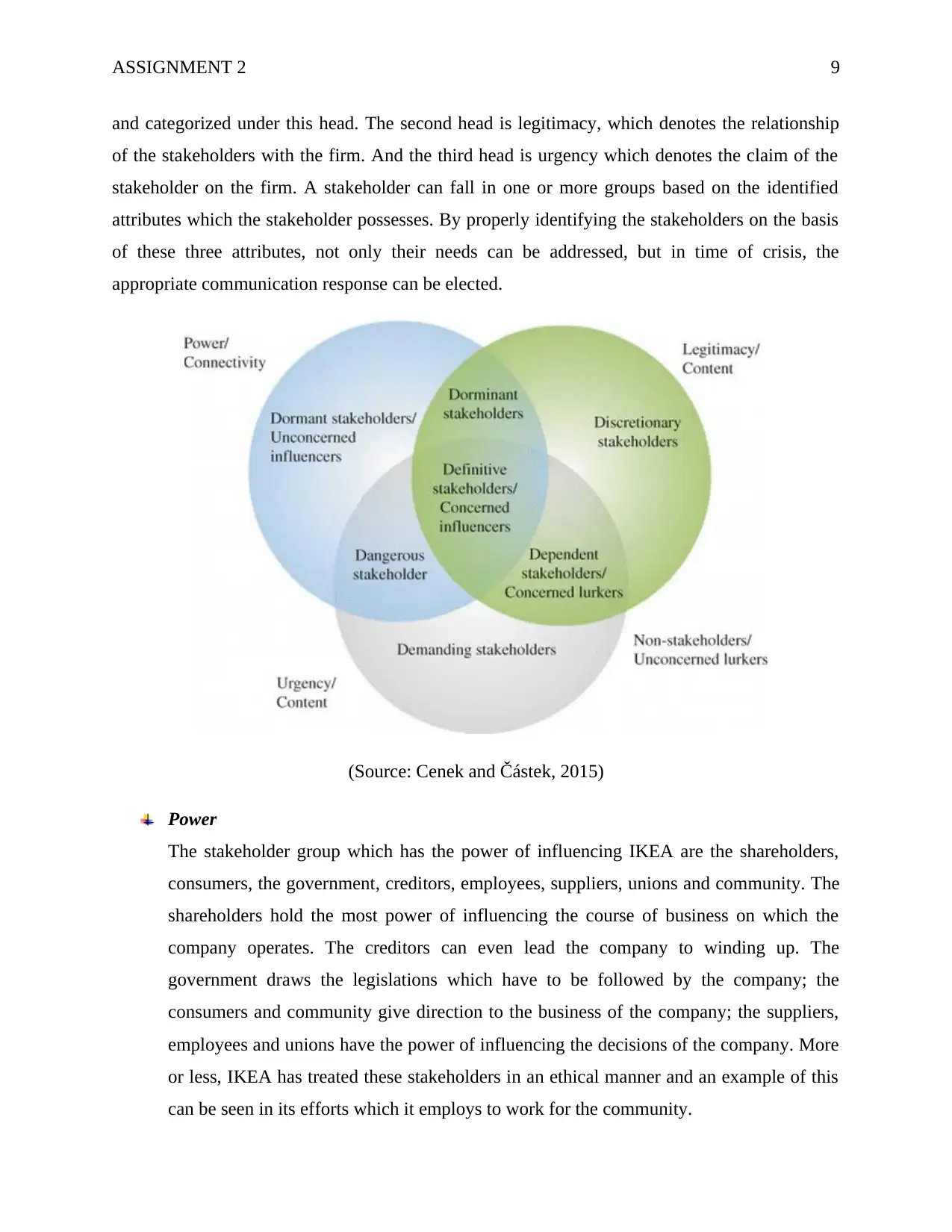
ASSIGNMENT 2 9
and categorized under this head. The second head is legitimacy, which denotes the relationship
of the stakeholders with the firm. And the third head is urgency which denotes the claim of the
stakeholder on the firm. A stakeholder can fall in one or more groups based on the identified
attributes which the stakeholder possesses. By properly identifying the stakeholders on the basis
of these three attributes, not only their needs can be addressed, but in time of crisis, the
appropriate communication response can be elected.
(Source: Cenek and Částek, 2015)
Power
The stakeholder group which has the power of influencing IKEA are the shareholders,
consumers, the government, creditors, employees, suppliers, unions and community. The
shareholders hold the most power of influencing the course of business on which the
company operates. The creditors can even lead the company to winding up. The
government draws the legislations which have to be followed by the company; the
consumers and community give direction to the business of the company; the suppliers,
employees and unions have the power of influencing the decisions of the company. More
or less, IKEA has treated these stakeholders in an ethical manner and an example of this
can be seen in its efforts which it employs to work for the community.
and categorized under this head. The second head is legitimacy, which denotes the relationship
of the stakeholders with the firm. And the third head is urgency which denotes the claim of the
stakeholder on the firm. A stakeholder can fall in one or more groups based on the identified
attributes which the stakeholder possesses. By properly identifying the stakeholders on the basis
of these three attributes, not only their needs can be addressed, but in time of crisis, the
appropriate communication response can be elected.
(Source: Cenek and Částek, 2015)
Power
The stakeholder group which has the power of influencing IKEA are the shareholders,
consumers, the government, creditors, employees, suppliers, unions and community. The
shareholders hold the most power of influencing the course of business on which the
company operates. The creditors can even lead the company to winding up. The
government draws the legislations which have to be followed by the company; the
consumers and community give direction to the business of the company; the suppliers,
employees and unions have the power of influencing the decisions of the company. More
or less, IKEA has treated these stakeholders in an ethical manner and an example of this
can be seen in its efforts which it employs to work for the community.
⊘ This is a preview!⊘
Do you want full access?
Subscribe today to unlock all pages.

Trusted by 1+ million students worldwide
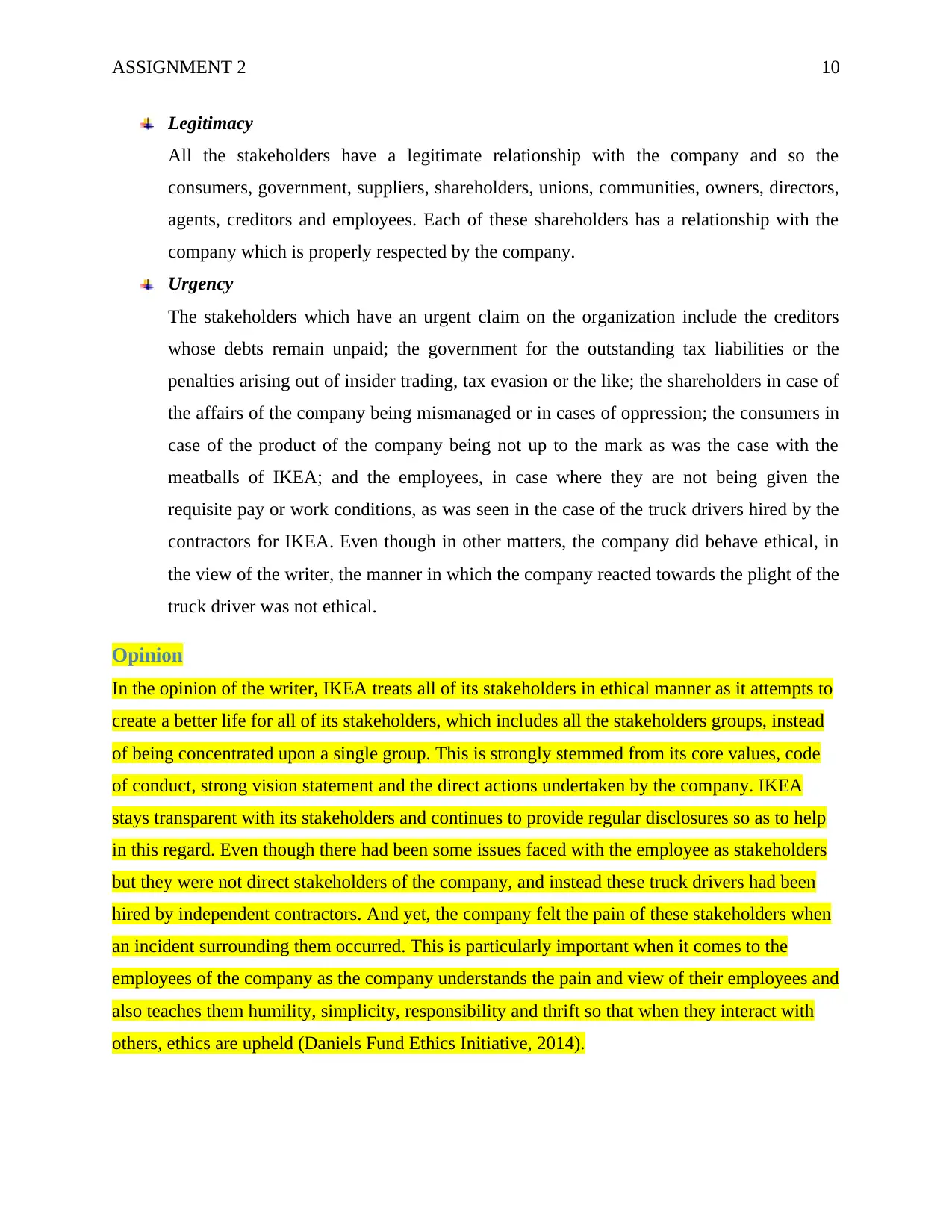
ASSIGNMENT 2 10
Legitimacy
All the stakeholders have a legitimate relationship with the company and so the
consumers, government, suppliers, shareholders, unions, communities, owners, directors,
agents, creditors and employees. Each of these shareholders has a relationship with the
company which is properly respected by the company.
Urgency
The stakeholders which have an urgent claim on the organization include the creditors
whose debts remain unpaid; the government for the outstanding tax liabilities or the
penalties arising out of insider trading, tax evasion or the like; the shareholders in case of
the affairs of the company being mismanaged or in cases of oppression; the consumers in
case of the product of the company being not up to the mark as was the case with the
meatballs of IKEA; and the employees, in case where they are not being given the
requisite pay or work conditions, as was seen in the case of the truck drivers hired by the
contractors for IKEA. Even though in other matters, the company did behave ethical, in
the view of the writer, the manner in which the company reacted towards the plight of the
truck driver was not ethical.
Opinion
In the opinion of the writer, IKEA treats all of its stakeholders in ethical manner as it attempts to
create a better life for all of its stakeholders, which includes all the stakeholders groups, instead
of being concentrated upon a single group. This is strongly stemmed from its core values, code
of conduct, strong vision statement and the direct actions undertaken by the company. IKEA
stays transparent with its stakeholders and continues to provide regular disclosures so as to help
in this regard. Even though there had been some issues faced with the employee as stakeholders
but they were not direct stakeholders of the company, and instead these truck drivers had been
hired by independent contractors. And yet, the company felt the pain of these stakeholders when
an incident surrounding them occurred. This is particularly important when it comes to the
employees of the company as the company understands the pain and view of their employees and
also teaches them humility, simplicity, responsibility and thrift so that when they interact with
others, ethics are upheld (Daniels Fund Ethics Initiative, 2014).
Legitimacy
All the stakeholders have a legitimate relationship with the company and so the
consumers, government, suppliers, shareholders, unions, communities, owners, directors,
agents, creditors and employees. Each of these shareholders has a relationship with the
company which is properly respected by the company.
Urgency
The stakeholders which have an urgent claim on the organization include the creditors
whose debts remain unpaid; the government for the outstanding tax liabilities or the
penalties arising out of insider trading, tax evasion or the like; the shareholders in case of
the affairs of the company being mismanaged or in cases of oppression; the consumers in
case of the product of the company being not up to the mark as was the case with the
meatballs of IKEA; and the employees, in case where they are not being given the
requisite pay or work conditions, as was seen in the case of the truck drivers hired by the
contractors for IKEA. Even though in other matters, the company did behave ethical, in
the view of the writer, the manner in which the company reacted towards the plight of the
truck driver was not ethical.
Opinion
In the opinion of the writer, IKEA treats all of its stakeholders in ethical manner as it attempts to
create a better life for all of its stakeholders, which includes all the stakeholders groups, instead
of being concentrated upon a single group. This is strongly stemmed from its core values, code
of conduct, strong vision statement and the direct actions undertaken by the company. IKEA
stays transparent with its stakeholders and continues to provide regular disclosures so as to help
in this regard. Even though there had been some issues faced with the employee as stakeholders
but they were not direct stakeholders of the company, and instead these truck drivers had been
hired by independent contractors. And yet, the company felt the pain of these stakeholders when
an incident surrounding them occurred. This is particularly important when it comes to the
employees of the company as the company understands the pain and view of their employees and
also teaches them humility, simplicity, responsibility and thrift so that when they interact with
others, ethics are upheld (Daniels Fund Ethics Initiative, 2014).
Paraphrase This Document
Need a fresh take? Get an instant paraphrase of this document with our AI Paraphraser
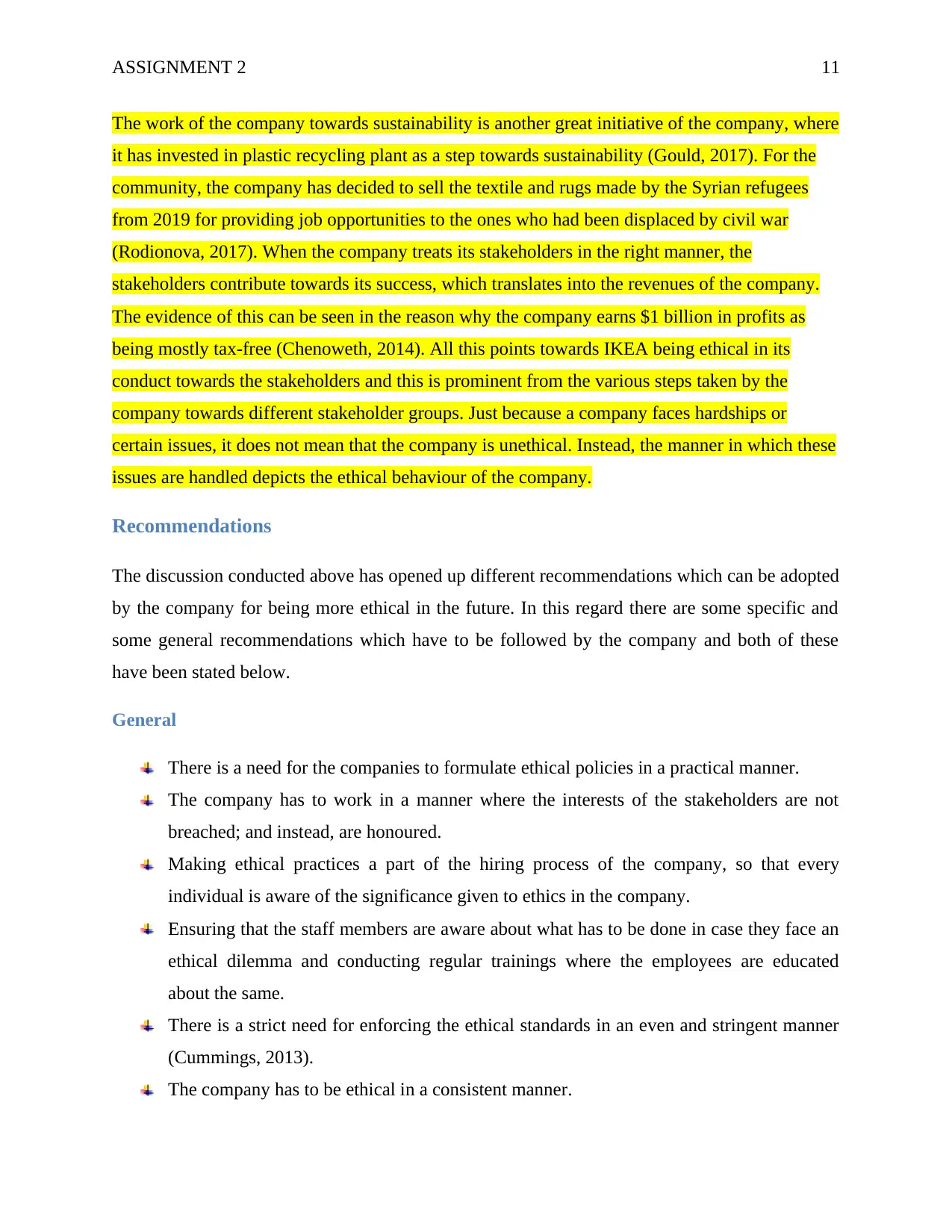
ASSIGNMENT 2 11
The work of the company towards sustainability is another great initiative of the company, where
it has invested in plastic recycling plant as a step towards sustainability (Gould, 2017). For the
community, the company has decided to sell the textile and rugs made by the Syrian refugees
from 2019 for providing job opportunities to the ones who had been displaced by civil war
(Rodionova, 2017). When the company treats its stakeholders in the right manner, the
stakeholders contribute towards its success, which translates into the revenues of the company.
The evidence of this can be seen in the reason why the company earns $1 billion in profits as
being mostly tax-free (Chenoweth, 2014). All this points towards IKEA being ethical in its
conduct towards the stakeholders and this is prominent from the various steps taken by the
company towards different stakeholder groups. Just because a company faces hardships or
certain issues, it does not mean that the company is unethical. Instead, the manner in which these
issues are handled depicts the ethical behaviour of the company.
Recommendations
The discussion conducted above has opened up different recommendations which can be adopted
by the company for being more ethical in the future. In this regard there are some specific and
some general recommendations which have to be followed by the company and both of these
have been stated below.
General
There is a need for the companies to formulate ethical policies in a practical manner.
The company has to work in a manner where the interests of the stakeholders are not
breached; and instead, are honoured.
Making ethical practices a part of the hiring process of the company, so that every
individual is aware of the significance given to ethics in the company.
Ensuring that the staff members are aware about what has to be done in case they face an
ethical dilemma and conducting regular trainings where the employees are educated
about the same.
There is a strict need for enforcing the ethical standards in an even and stringent manner
(Cummings, 2013).
The company has to be ethical in a consistent manner.
The work of the company towards sustainability is another great initiative of the company, where
it has invested in plastic recycling plant as a step towards sustainability (Gould, 2017). For the
community, the company has decided to sell the textile and rugs made by the Syrian refugees
from 2019 for providing job opportunities to the ones who had been displaced by civil war
(Rodionova, 2017). When the company treats its stakeholders in the right manner, the
stakeholders contribute towards its success, which translates into the revenues of the company.
The evidence of this can be seen in the reason why the company earns $1 billion in profits as
being mostly tax-free (Chenoweth, 2014). All this points towards IKEA being ethical in its
conduct towards the stakeholders and this is prominent from the various steps taken by the
company towards different stakeholder groups. Just because a company faces hardships or
certain issues, it does not mean that the company is unethical. Instead, the manner in which these
issues are handled depicts the ethical behaviour of the company.
Recommendations
The discussion conducted above has opened up different recommendations which can be adopted
by the company for being more ethical in the future. In this regard there are some specific and
some general recommendations which have to be followed by the company and both of these
have been stated below.
General
There is a need for the companies to formulate ethical policies in a practical manner.
The company has to work in a manner where the interests of the stakeholders are not
breached; and instead, are honoured.
Making ethical practices a part of the hiring process of the company, so that every
individual is aware of the significance given to ethics in the company.
Ensuring that the staff members are aware about what has to be done in case they face an
ethical dilemma and conducting regular trainings where the employees are educated
about the same.
There is a strict need for enforcing the ethical standards in an even and stringent manner
(Cummings, 2013).
The company has to be ethical in a consistent manner.
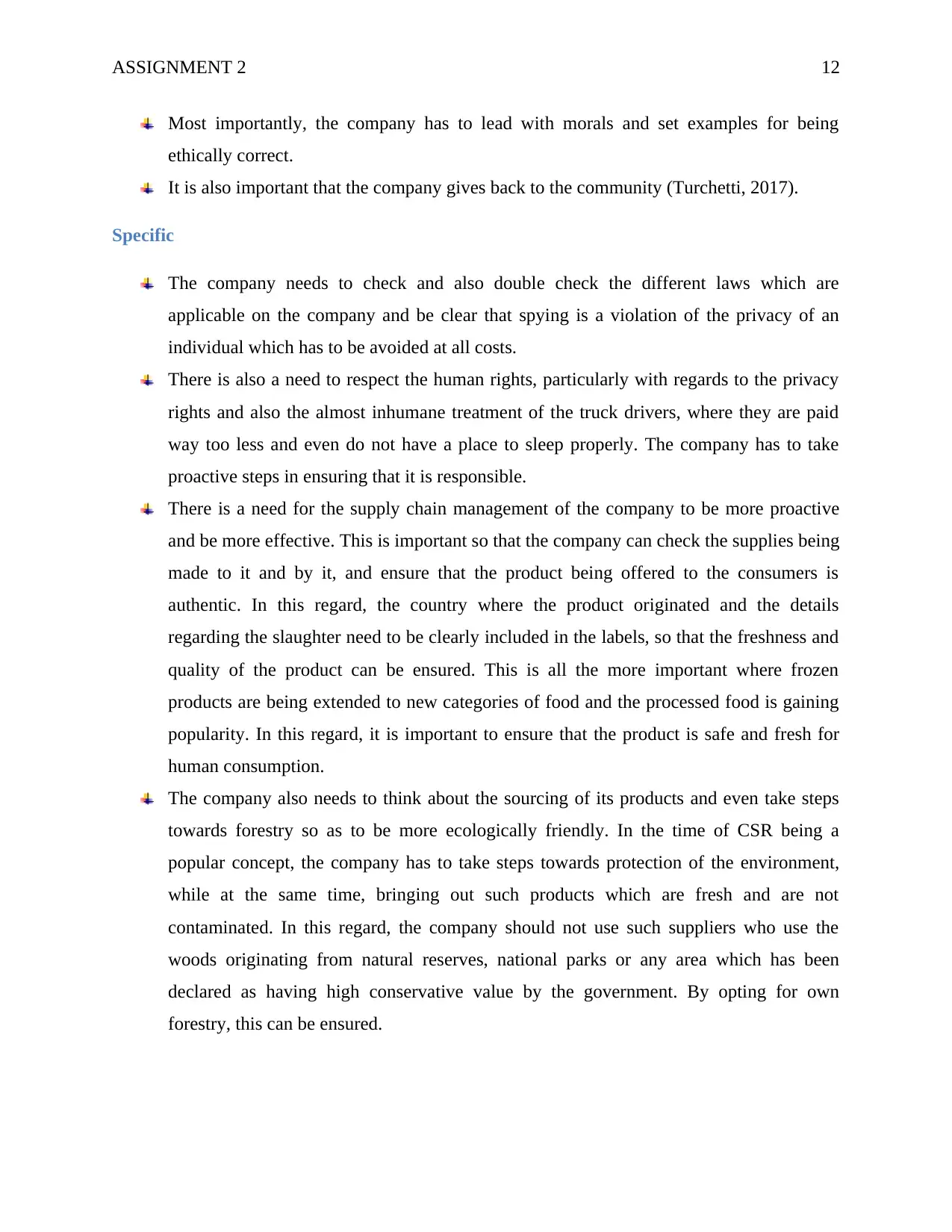
ASSIGNMENT 2 12
Most importantly, the company has to lead with morals and set examples for being
ethically correct.
It is also important that the company gives back to the community (Turchetti, 2017).
Specific
The company needs to check and also double check the different laws which are
applicable on the company and be clear that spying is a violation of the privacy of an
individual which has to be avoided at all costs.
There is also a need to respect the human rights, particularly with regards to the privacy
rights and also the almost inhumane treatment of the truck drivers, where they are paid
way too less and even do not have a place to sleep properly. The company has to take
proactive steps in ensuring that it is responsible.
There is a need for the supply chain management of the company to be more proactive
and be more effective. This is important so that the company can check the supplies being
made to it and by it, and ensure that the product being offered to the consumers is
authentic. In this regard, the country where the product originated and the details
regarding the slaughter need to be clearly included in the labels, so that the freshness and
quality of the product can be ensured. This is all the more important where frozen
products are being extended to new categories of food and the processed food is gaining
popularity. In this regard, it is important to ensure that the product is safe and fresh for
human consumption.
The company also needs to think about the sourcing of its products and even take steps
towards forestry so as to be more ecologically friendly. In the time of CSR being a
popular concept, the company has to take steps towards protection of the environment,
while at the same time, bringing out such products which are fresh and are not
contaminated. In this regard, the company should not use such suppliers who use the
woods originating from natural reserves, national parks or any area which has been
declared as having high conservative value by the government. By opting for own
forestry, this can be ensured.
Most importantly, the company has to lead with morals and set examples for being
ethically correct.
It is also important that the company gives back to the community (Turchetti, 2017).
Specific
The company needs to check and also double check the different laws which are
applicable on the company and be clear that spying is a violation of the privacy of an
individual which has to be avoided at all costs.
There is also a need to respect the human rights, particularly with regards to the privacy
rights and also the almost inhumane treatment of the truck drivers, where they are paid
way too less and even do not have a place to sleep properly. The company has to take
proactive steps in ensuring that it is responsible.
There is a need for the supply chain management of the company to be more proactive
and be more effective. This is important so that the company can check the supplies being
made to it and by it, and ensure that the product being offered to the consumers is
authentic. In this regard, the country where the product originated and the details
regarding the slaughter need to be clearly included in the labels, so that the freshness and
quality of the product can be ensured. This is all the more important where frozen
products are being extended to new categories of food and the processed food is gaining
popularity. In this regard, it is important to ensure that the product is safe and fresh for
human consumption.
The company also needs to think about the sourcing of its products and even take steps
towards forestry so as to be more ecologically friendly. In the time of CSR being a
popular concept, the company has to take steps towards protection of the environment,
while at the same time, bringing out such products which are fresh and are not
contaminated. In this regard, the company should not use such suppliers who use the
woods originating from natural reserves, national parks or any area which has been
declared as having high conservative value by the government. By opting for own
forestry, this can be ensured.
⊘ This is a preview!⊘
Do you want full access?
Subscribe today to unlock all pages.

Trusted by 1+ million students worldwide
1 out of 17
Related Documents
Your All-in-One AI-Powered Toolkit for Academic Success.
+13062052269
info@desklib.com
Available 24*7 on WhatsApp / Email
![[object Object]](/_next/static/media/star-bottom.7253800d.svg)
Unlock your academic potential
Copyright © 2020–2025 A2Z Services. All Rights Reserved. Developed and managed by ZUCOL.





